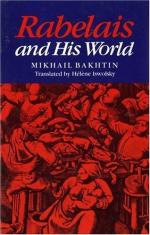
|
| Name: _________________________ | Period: ___________________ |
This quiz consists of 5 multiple choice and 5 short answer questions through Chapter 12, Chapter 4 - Banquet Imagery & Chapter 5 - The Grotesque Image of the Body and Its Sources.
Multiple Choice Questions
1. What are examples of carnivalesque victims?
(a) Debased clowns and slaughtered oxen.
(b) Blushing virgins and old maids.
(c) Peasants and tax collectors.
(d) Stray dogs and street orphans.
2. Bakhtin asserts that beatings, death, feasting, and merrymaking are all integral parts of:
(a) Rabelais' view of the proper treatment of foreigners and peasants.
(b) The Renaissance notion that all which is already established is perfect.
(c) The methods of marketplace vendors in overpricing their goods.
(d) The Renaissance system of images that is perpetually regenerative and never decaying.
3. How does the Lord of Basche contrive to bring Catchpoles to his castle?
(a) By celebrating Mass.
(b) By offering people absolution from their sins.
(c) By celebrating mock weddings.
(d) By giving away his possessions.
4. "The Treatise of Garcia of Toledo," which Bakhtin cites, is notable for:
(a) Its disregard for the festive tradition.
(b) Its simple philosophy of religious asceticism.
(c) Its portrayal of the gluttony of the Pope.
(d) Its retelling of ancient myths and fables.
5. What does Bakhtin find inadequate in Veselovsky's metaphor of Rabelais as a village boy?
(a) Veselovsky's image is cynical, but Rabelais actually celebrates regenerative laughter.
(b) Veselovsky's image excludes the seriousness of the boy as a budding scholar.
(c) Veselovsky's image seems too urban for Rabelais, who only wrote about the countryside.
(d) Veselovsky's image is too young at heart, for Rabelais wrote only with an old, tired voice.
Short Answer Questions
1. One of Rabelais' main sources for his enumerations of food was a Medieval treatise about:
2. In the folklore and grotesque realism of Rabelais' works, excrement represents bodies and matter that are:
3. What do wine and oil symbolize in Rabelais' novel?
4. Bakhtin notes that two of the most commonly combined themes in Medieval popular literature relating to monks are:
5. Why was Rabelais linked so closely to the Lyon fairs?
|
This section contains 408 words (approx. 2 pages at 300 words per page) |

|




